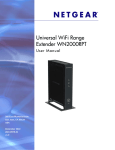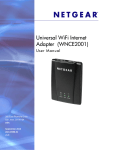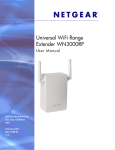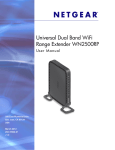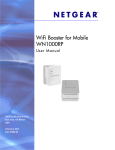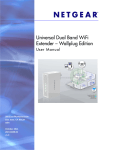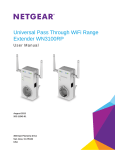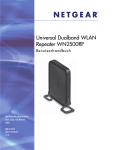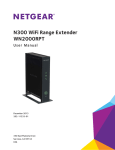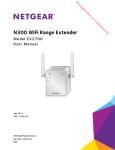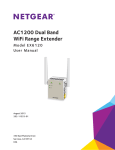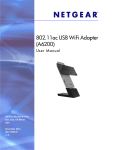Download Netgear WN2000RPTv2 User Guide
Transcript
Universal WiFi Range Extender WN2000RPT User Manual 350 East Plumeria Drive San Jose, CA 95134 USA March 2012 202-10579-02 v1.0 Universal WiFi Range Extender WN2000RPT © 2012 NETGEAR, Inc. All rights reserved No part of this publication may be reproduced, transmitted, transcribed, stored in a retrieval system, or translated into any language in any form or by any means without the written permission of NETGEAR, Inc. Technical Support Thank you for choosing NETGEAR. To register your product, get the latest product updates, get support online, or for more information about the topics covered in this manual, visit the Support website at http://support.netgear.com Phone (US & Canada only): 1-888-NETGEAR Phone (Other Countries): Check the list of phone numbers at http://support.netgear.com/app/answers/detail/a_id/984 Trademarks NETGEAR, the NETGEAR logo, and Connect with Innovation are trademarks and/or registered trademarks of NETGEAR, Inc. and/or its subsidiaries in the United States and/or other countries. Information is subject to change without notice. Other brand and product names are registered trademarks or trademarks of their respective holders. © 2011 NETGEAR, Inc. All rights reserved. Statement of Conditions To improve internal design, operational function, and/or reliability, NETGEAR reserves the right to make changes to the products described in this document without notice. NETGEAR does not assume any liability that may occur due to the use, or application of, the product(s) or circuit layout(s) described herein. 2 Table of Contents Chapter 1 Getting Started Front Panel . . . . . . . . . . . . . . . . . . . . . . . . . . . . . . . . . . . . . . . . . . . . . . . . . . 5 Rear Panel . . . . . . . . . . . . . . . . . . . . . . . . . . . . . . . . . . . . . . . . . . . . . . . . . . 5 How the Extender Works . . . . . . . . . . . . . . . . . . . . . . . . . . . . . . . . . . . . . . . 6 When to Use Your Extender. . . . . . . . . . . . . . . . . . . . . . . . . . . . . . . . . . . 6 Positioning Your Extender . . . . . . . . . . . . . . . . . . . . . . . . . . . . . . . . . . . . 7 Connect a PC to the Extender with an Ethernet Cable . . . . . . . . . . . . . . . . 8 Log In to the Extender . . . . . . . . . . . . . . . . . . . . . . . . . . . . . . . . . . . . . . . . . 9 Use the Setup Wizard. . . . . . . . . . . . . . . . . . . . . . . . . . . . . . . . . . . . . . . . . 10 Chapter 2 Extender Network Settings Connect the Extender to an Existing Network . . . . . . . . . . . . . . . . . . . . . . 14 Use WPS to Add a Computer to the Extender’s Wireless Network . . . . . . 15 Extender Wireless Settings . . . . . . . . . . . . . . . . . . . . . . . . . . . . . . . . . . . . 16 WPA, WPA2, or WPA + WPA2. . . . . . . . . . . . . . . . . . . . . . . . . . . . . . . . 17 WEP . . . . . . . . . . . . . . . . . . . . . . . . . . . . . . . . . . . . . . . . . . . . . . . . . . . . 17 Extender IP Address Setup . . . . . . . . . . . . . . . . . . . . . . . . . . . . . . . . . . . . 18 Status Screen . . . . . . . . . . . . . . . . . . . . . . . . . . . . . . . . . . . . . . . . . . . . . . . 19 Show Statistics . . . . . . . . . . . . . . . . . . . . . . . . . . . . . . . . . . . . . . . . . . . . 21 Network Devices. . . . . . . . . . . . . . . . . . . . . . . . . . . . . . . . . . . . . . . . . . . . . 22 Back Up and Manage Extender Settings . . . . . . . . . . . . . . . . . . . . . . . . . . 22 Set the Password . . . . . . . . . . . . . . . . . . . . . . . . . . . . . . . . . . . . . . . . . . . . 23 Upgrade the Firmware . . . . . . . . . . . . . . . . . . . . . . . . . . . . . . . . . . . . . . . . 24 Advanced Wireless Settings. . . . . . . . . . . . . . . . . . . . . . . . . . . . . . . . . . . . 25 Chapter 3 Troubleshooting Smart Wizard FAQs . . . . . . . . . . . . . . . . . . . . . . . . . . . . . . . . . . . . . . . . . . 26 Connecting to http://www.mywifiext.net . . . . . . . . . . . . . . . . . . . . . . . . . . . 26 Joining Wireless Networks . . . . . . . . . . . . . . . . . . . . . . . . . . . . . . . . . . . . . 27 Appendix A Factory Settings and Technical Specifications Factory Settings . . . . . . . . . . . . . . . . . . . . . . . . . . . . . . . . . . . . . . . . . . . . . 28 Technical Specifications . . . . . . . . . . . . . . . . . . . . . . . . . . . . . . . . . . . . . . . 29 Appendix B Compliance Notification 3 1. 1 Getting Started This chapter covers the following topics: • Front Panel • Rear Panel • How the Extender Works • Connect a PC to the Extender with an Ethernet Cable • Log In to the Extender • Use the Setup Wizard For help with installation, see the Universal WiFi Extender WN2000RPT Installation Guide that came in the package. For more information about the topics covered in this manual, visit the Support website at http://support.netgear.com. 4 Universal WiFi Range Extender WN2000RPT Front Panel Table 1. Front View LEDs and Button Description Link Rate The wireless connection between the extender and the router is optimum. The wireless connection between the extender and the router is good. The wireless connection between the extender and the router is poor. Extender Status The extender is powered on. PC to Extender Connection The extender is connected to a PC. WPS button The WPS button allows you to connect your computer to the extender using Push 'N' Connect. Rear Panel Factory Reset button Ethernet ports Power On/Off button Figure 1. Rear panel Getting Started 5 Universal WiFi Range Extender WN2000RPT How the Extender Works The extender works like a bridge between a wireless router and a computer or wireless device outside the wireless router’s range. To do this, the extender has two main jobs: 1. The extender connects to a wireless network that is up and running. When the extender connects wirelessly to a network, it acts as a network client. This is similar to how a computer connects to a network. 2. The extender acts as an access point for computers. The extender has its own wireless network called NETGEAR_EXT that wireless computers can join. In its role as an access point, the extender performs tasks that wireless routers do, such as broadcasting its network name (SSID). The extender must do each of these jobs so that both ends of the bridge are in place. Extender Router Computer outside the router’s range Router The Extender is halfway between the router and the computer. Figure 2. Range Extender in a home When to Use Your Extender NETGEAR recommends that you connect to the extender only when your home network connection is poor. Because data traffic routed through the extender is inherently slower than traffic routed directly from the network, the computer should stay on the network if the connection is good enough. NETGEAR recommends that you connect through the extender network only when the computer is in a “dead zone” where connection from the network is very poor or non-existent. Getting Started 6 Universal WiFi Range Extender WN2000RPT The extender LEDs can help you tell if the extender is correctly set up and working as it should. • The best performance is delivered when both the Link Rate LED are green. Extender Connection LED and the PC to • A workable performance is delivered when the Link Rate LED is amber is green. to Extender Connection LED and the PC Positioning Your Extender The ideal location to place the extender is half-way between your wireless router and your computer. Figure 3. Range extender location The best connection is established when there is a clear line of sight between the extender and the wireless router and also a clear line of sight between the extender and the computer you are using. If this straight path is blocked by a thick wall or other materials, move the extender to a different location half-way between the computer and the router. If there is no power outlet nearby, or you prefer to place the extender elsewhere, move the extender closer to the computer. If the Link Rate LED is green or amber and the PC to Extender Connection LED is green, the extender is working as expected. To improve the Link Rate LED from red or amber to green: • Once you successfully connect to the extender from a computer that is outside the range of your router and log in to www.mywifiext.net, the Smart Wizard guides you through the process to connect the extender to a router. • If the Link Rate LED is red or the Smart Wizard cannot connect the extender to a router, move the extender closer to the router or to a different spot where it provides a better line of sight. As you move the extender, continue to check the Link Rate and the PC to Extender Connection LEDs on the front panel until you find a location where the Link Rate LED is green or amber, and the PC to Extender Connection LED is green. Note that you might have to unplug the extender as you move it to a different location. If you do, from the new location, power up the extender and continue to check the LEDs. Once the LEDs show that the extender is in a good location, open a browser and go to http://www.mywifiext.net to continue the setup process. Getting Started 7 Universal WiFi Range Extender WN2000RPT Connect a PC to the Extender with an Ethernet Cable Usually, you connect to the extender wirelessly, but you can use its LAN ports to connect wired devices such as Ethernet-enabled gaming consoles, printers, or PCs. Note: Before you connect wired devices or computers, first install and set up your extender as described in the Universal WiFi Extender WN2000RPT Installation Guide that came in the package. 1. Connect your computer to the extender with an Ethernet cable. 2. Connect the extender power adapter, and plug it into an electrical outlet. CAUTION: Do not use Ethernet cable to connect the extender to a router. If you do so, the extender does not work because it is designed to use only a wireless connection to the router. 3. Log in as described in the following section. If you have trouble connecting: • If you start your computer, connect the Ethernet cable to the extender, and launch your browser quickly, the computer might still need a couple of minutes to recognize the Ethernet LAN connection before you can connect. • Make sure that your Ethernet cable is securely connected to the extender and the computer, and that the extender LAN LED is on. If the LED is not lit reconnect the Ethernet cable, and relaunch your Internet browser. Getting Started 8 Universal WiFi Range Extender WN2000RPT Log In to the Extender You can log in to the extender to to view or change the extender’s settings. If you connect to the extender before it has been set up, the browser automatically goes to www.mywifiext.net and displays the NETGEAR Genie screens that step you through the setup process. See the Universal WiFi Extender WN2000RPT Installation Guide for information about initial set up. To log in after initial set up: 1. On your computer, launch an Internet browser such as Mozilla Firefox or Microsoft Internet Explorer. 2. In the address field of your browser, enter http://www.mywifiext.net. You are prompted to enter a user name and password: If you do not see the login prompt, make sure to include http:// when you type http://www.mywifiext.net in your browser. 3. Type admin for the user name. The default password is password. NETGEAR recommends that you set a more secure password after you log in (see Set the Password on page 23). • If your extender has an Internet connection, the Firmware Upgrade screen displays (see Upgrade the Firmware on page 24), and the software automatically checks for new firmware at the NETGEAR website. • The Status screen displays. Menu selections are on the left. The Status screen shows what the current settings are for the extender: Getting Started 9 Universal WiFi Range Extender WN2000RPT Use the Setup Wizard The Setup Wizard can help you set up your extender to connect to a wireless network. For information about more configuration options, see Chapter 2, Extender Network Settings. To use the Setup Wizard: 1. Select Setup Wizard. The following screen displays: This is the same Smart Wizard that displays during installation as described in the installation guide. 2. Either select a network from the list, or select the Manually input my wireless SSID radio button and type the SSID. 3. Enter the passphrase for your wireless network and click Continue. The next screen displays: Getting Started 10 Universal WiFi Range Extender WN2000RPT 4. Make sure that the correct network name is shown, and then click Continue. The following screens display: 5. Click OK, and the following screen displays: At this point, the extender is connected to your home network, but your computer has not joined the wireless network of the extender. 6. With a wireless computer or device, join the extender’s wireless network. 7. Scroll down to the bottom of the screen, select the check box, and click Continue. Note: Until you select the check box, the Continue button is grayed out. Getting Started 11 Universal WiFi Range Extender WN2000RPT The following screen displays: 8. Click Finish. You are asked if you want to bookmark the page, and then prompted to close the screen. Getting Started 12 2. Extender Network Settings 2 This chapter covers the following topics: • Connect the Extender to an Existing Network on page 14 • Use WPS to Add a Computer to the Extender’s Wireless Network • Extender Wireless Settings • Extender IP Address Setup • Status Screen • Network Devices • Back Up and Manage Extender Settings • Set the Password • Upgrade the Firmware • Advanced Wireless Settings To change settings, connect the extender to your computer and use your Internet browser to go to http://www.mywifiext.net as described in Connect a PC to the Extender with an Ethernet Cable on page 8. 13 Universal WiFi Range Extender WN2000RPT Connect the Extender to an Existing Network You can wirelessly connect the extender to your home network. 1. Select Setup > Connect to an Existing Network. The extender scans for wireless networks, and displays a list. If your wireless network is not on the list, and it is up and running, see Positioning Your Extender on page 7 for suggestions. 2. Click the radio button to select your network from the list and click Continue. If you selected the manual option, you are prompted to type the network name (SSID) and to enter the password to access it: 3. Enter your network’s passphrase or key and click Continue. The extender joins your wireless network. Extender Network Settings 14 Universal WiFi Range Extender WN2000RPT Use WPS to Add a Computer to the Extender’s Wireless Network WPS (Wi-Fi Protected Setup) lets you connect a computer or wireless device to the extender’s network without entering the wireless network passphrase or key. Instead, you use a WPS button or enter a PIN to connect. WPS supports WPA and WPA2 wireless security. If your extender network is open (no wireless security is set), then connecting with WPS automatically sets WPA2 + WPA wireless security on the extender network. Note: You cannot use the Push 'N' Connect WPS button to connect the extender to your wireless network. The WPS button on the extender can be used only to connect a computer to the extender. The Universal WiFi Extender WN2000RPT Installation Guide explains how to use WPS during installation. To join the extender’s network using WPS after installation: 1. Select Setup > Add WPS Client. Click Next and the following screen displays: 2. Select a radio button. • Push Button (recommended). Either click the button on the front of the extender. • button or press the WPS PIN Number. Select the radio button, and a PIN displays. The extender tries to find the wireless client (the computer) that is attempting to join the network. If you are using a WPS button, it tries for 2 minutes. If you are using a PIN, it tries for 4 minutes. 3. Go to your wireless computer. Use its WPS software to try to connect to the extender. The first time you add a WPS client, WPS automatically sets the extender’s wireless security to WPA2 + WPA with a random passphrase. You can view these settings in the Wireless Settings screen, described in the following section. Extender Network Settings 15 Universal WiFi Range Extender WN2000RPT Extender Wireless Settings You can use the Wireless Settings screen to change the network name (SSID) for the extender’s network and to set up wireless security. If you do not change these settings, the network name is NETGEAR_EXT, and the network is open (no wireless security is set up). Note: If you use a wireless computer to change the extender’s wireless settings, you will be disconnected when you click Apply. To reconnect, you must select the new network name that you created, and enter the passphrase or wireless security key that you set up. To change the wireless settings for the extender’s network: 1. Select Setup > Wireless Settings to display the following screen: 2. In the Name (SSID) field, you can type in a new name to customize your extender network. This will make it easier to identify your extender if more than one is operating in your neighborhood. 3. In the Security Options section of the screen, select the type of wireless security that you want to use on your network. • None. This is an open wireless network. Any wireless computer or device is allowed to join this network. • WEP. WEP is an older standard, and is less secure than WPA or WPA2. WEP uses encryption keys and data encryption for data security. You can select 64-bit or 128-bit encryption. • WPA-PSK [TKIP]. WPA is more secure than WEP. When using wireless computers or devices that support WPA, you can enter a passphrase to join the extender’s wireless network. • WPA2-PSK [AES]. WPA2 is even more secure, but some older computers do not support this standard. When using wireless computers or devices that support WPA2, you can enter the passphrase to join the extender’s wireless network. Extender Network Settings 16 Universal WiFi Range Extender WN2000RPT • WPA-PSK [TKIP] + WPA2-PASK [AES]. When using wireless computers or devices that support either WPA or WPA2, you can enter the passphrase to join the extender’s wireless network. 4. Click Apply to save your settings. 5. Use your wireless computer to connect to the extender’s network with its new settings. The Smart Wizard can guide you through this process. 6. WPA, WPA2, or WPA + WPA2 Both WPA and WPA2 provide strong data security. WPA with TKIP can be used on Windows systems with Service Pack 2 or later. WPA2 with AES is a hardware implementation; see your device documentation before implementing it. To configure WPA or WPA2 in the extender: 1. On the Wireless Setting screen, select the radio button for the WPA or WPA2 option of your choice. 2. The settings displayed on the screen depend on which security option you select. 3. For WPA-PSK or WPA2-PSK, enter the passphrase. 4. Click Apply to save your settings. WEP WEP is a legacy wireless security setting. NETGEAR recommends that you use WPA2 or WPA unless your legacy wireless equipment does not support those standards. To set up WEP: 1. In the Wireless Settings screen, in the Security Options section, select the WEP radio button. 2. Select the authentication type: Automatic, Open System, or Shared Key. The default is Open System. Note: The authentication is separate from the data encryption. You can select authentication that requires a shared key, but still leaves data transmissions unencrypted. Security is stronger if you use both the Shared Key and WEP encryption settings. 3. Select the encryption strength setting: • WEP 64-bit encryption. Enter 10 hexadecimal digits (any combination of 0–9, a–f, or A–F). • WEP 128-bit encryption. Enter 26 hexadecimal digits (any combination of 0–9, a–f, or A–F). Extender Network Settings 17 Universal WiFi Range Extender WN2000RPT 4. Enter the encryption keys. You can manually or automatically program the four data encryption keys. These values must be identical on all computers and access points in your network: • Passphrase. To use a passphrase to generate the keys, enter a passphrase, and click Generate. This automatically creates the keys. Wireless computers must use the passphrase or keys to access the extender. Note: Not all wireless computers support passphrase key generation. If your computer does not support the passphrase, then you will need to type the encryption key in order to join the wireless network. • Key 1–Key 4. These values are not case-sensitive. You can manually enter the four data encryption keys. These values must be identical on all computers and access points in your network. Enter 10 hexadecimal digits (any combination of 0–9, a–f, or A–F). 5. Select which of the four keys will be the default. Data transmissions are always encrypted using the default key. The other keys can be used only to decrypt received data. The four entries are disabled if WPA-PSK or WPA authentication is selected. 6. Click Apply to save your settings. Extender IP Address Setup Select extender Maintenance > IP Address to display the following screen: The IP Address screen shows whether the extender is set to get its IP address dynamically from the router (this is the most common setting), or is set as a static IP address. • Get Dynamically From Router. The wireless network router assigns an IP address when the extender connects to its wireless network. Most networks are set up so that the router automatically does this. Extender Network Settings 18 Universal WiFi Range Extender WN2000RPT • Use Static IP Address. Specify a static IP address. This is not usually necessary. If you set this up, you should be technically experienced or have a technically experienced person help you. - IP Address. The static IP address. - IP Subnet Mask. The subnet mask associated with the IP address. - Gateway IP Address. The IP address for the gateway. - Primary DNS. The primary domain name server (DNS). - Secondary DNS. The secondary domain name server (DNS). Status Screen When you connect to http://www.mywifiext.net, after the automatic firmware check, the Status screen displays. You can also select Maintenance > Status to display this screen: This screen shows the current settings and the status of your extender. You can click Show Statistics to see device performance statistics such as the number of packets sent and number of packets received for each port. See Show Statistics on page 21. The following table describes the fields in the Status screen. Table 2. Status Settings Field Description Hardware Version The hardware version of the extender. Firmware Version The current firmware version of the extender. If you upgrade the firmware, this field changes. Extender Network Settings 19 Universal WiFi Range Extender WN2000RPT Table 2. Status Settings (continued) Field Description GUI Language Version The language version running on the extender. If you upgrade the firmware, this field changes. Connection Status to Existing Network Extender PC Info Extender Wireless Settings Name (SSID) Your extender is set up to connect to this SSID, also called the wireless name. Connection Status The status of your wireless connection (connected or disconnected). Link Rate The actual transmission (Tx) and receive (Rx) link rate in the current wireless connection. MAC Address The physical address of the extender, as seen from the local area network (LAN). IP Address The IP address of the extender. The default is 192.168.1.250. DHCP Server Identifies the network DHCP server on the wireless network. IP Subnet Mask The IP subnet mask associated with the LAN IP address of the extender. The default is 255.255.255.0. Gateway IP Address The IP address of the wireless network gateway. Domain Name Server The IP address of the Domain Name Server (DNS) of the wireless network. Name (SSID) The name (SSID) or the wireless network. Region The location where the extender is operating. Channel The channel of the wireless network. Wireless AP On or Off. Broadcast Name On or Off. Wi-Fi Protected Setup Configured. Extender Network Settings 20 Universal WiFi Range Extender WN2000RPT Show Statistics On the Status screen, click Show Statistics to display the following screen: Table 3. Show Statistics Fields Field Description LAN or WLAN (Port) The statistics for the LAN (local), and wireless LAN (WLAN) ports. For each port, the screen displays the following: Status The link status of the port. TxPkts The number of packets transmitted on this port since reset or manual clear. RxPkts The number of packets received on this port since reset or manual clear. Collisions The number of collisions on this port since reset or manual clear. Tx B/s The current line utilization—percentage of current bandwidth used on this port. Rx B/s The average line utilization for this port. Up Time The time elapsed since the last power cycle or reset. Poll Interval Specify the poll interval frequency. If you change this value, click Set Interval so that your change takes effect. Extender Network Settings 21 Universal WiFi Range Extender WN2000RPT Network Devices Select Maintenance > Network Devices to display the following screen: Back Up and Manage Extender Settings Select Maintenance > Backup Settings to display this screen. The Backup and Restore options in the Backup Settings screen let you save and retrieve a file containing your extender’s configuration settings. Once you have your extender working correctly, you should back up the information to have it available if something goes wrong. When you back up the settings, they are saved as a file on your computer. You can restore the device’s settings from this file. To back up settings: 1. Click Backup. Your browser extracts the configuration file from the extender. 2. If you do not have your browser set up to save downloaded files automatically, locate where you want to save the file. 3. You can give the file a meaningful name at this time, such as internet_adapter.cfg. To restore settings: 1. On the Backup Settings screen, click Browse. 2. Locate and select the previously saved backup file. Extender Network Settings 22 Universal WiFi Range Extender WN2000RPT 3. Click Restore. A screen displays letting you know that the device has been successfully restored to the previous settings. The extender restarts. This takes about 1 minute. CAUTION: Do not try to go online, turn off the extender, shut down the computer, or do anything else to the extender until it finishes restarting! 4. Close the message window. To restore your settings from a saved configuration file, enter the full path to the file on your computer, or click Browse to browse to the file. When you have located it, click Restore to send the file to the extender. The extender then reboots automatically. To erase the settings” Under some circumstances (for example, if you have lost track of the changes that you made to the extender settings), you might want to erase the configuration. After an erase, the extender returns to its factory settings (see Factory Settings on page 28). To erase the configuration, click the Erase button in the Backup Settings screen. CAUTION: Do not try to go online, turn off the extender, shut down the computer, or do anything else to the extender until it finishes restarting! Set the Password The user name to access the extender is admin, and its default password is password. NETGEAR strongly recommends that you set a more secure password. From the extender menu at http://www.mywifiext.net, under the Maintenance heading, select Set Password. The following screen displays: Type the old password, type the new password twice, and then click Apply. Extender Network Settings 23 Universal WiFi Range Extender WN2000RPT Upgrade the Firmware Unless you changed the settings in the Firmware Upgrade screen previously, the extender is set up to check for new firmware automatically at log in. If you do not want to use the automatic firmware check, clear the Check for New Version Upon Login check box. To check for firmware and upgrade if it is available: 1. Select Maintenance > Firmware Upgrade. The following screen displays: 2. Click Check to see if new firmware is available. If it is, follow the onscreen prompts to download it onto your computer. 3. Use the Browse field to locate and select the new firmware. 4. Click Upload to install the new firmware on your extender. CAUTION: Once you start the firmware upgrade, do not try to go online, turn off the extender, shut down the computer, or do anything else to the extender until it finishes restarting! Extender Network Settings 24 Universal WiFi Range Extender WN2000RPT Advanced Wireless Settings The extender is already configured with the optimum settings. Do not alter these settings unless directed by NETGEAR support. Incorrect settings might disable the extender unexpectedly. To view or change the advanced wireless settings: From the extender menu at http://www.mywifiext.net, under the Advanced heading, select Wireless Settings. The following screen displays: You can view or configure the following settings: • Enable Wireless Access Point. Enable the extender to work as a wireless access point. If this check box is cleared, then computers or wireless devices cannot connect wirelessly to the extender. • Enable SSID Broadcast. Enable the extender to broadcast its wireless network name (SSID). If this check box is cleared, then the wireless network is hidden. To join a hidden wireless network, you have to type the wireless name. • Disable Device’s PIN. Selecting this check box disables the extender’s PIN. The PIN can be used for a WPS wireless connection. • Keep Existing Wireless Settings. When this check box is selected, the settings in the Wireless Settings screen stay the same when WPS is used for a wireless connection. • Setup Access List. Specify a list of computers or wireless devices that are allowed to connect to the network. If you use an access list, then computers that are not on the list are not allowed to join the wireless network. Extender Network Settings 25 3. 3 Troubleshooting Smart Wizard FAQs 1. When I connect to the network, Smart Wizard keeps asking me for my passphrase, and I am sure I’ve entered the correct passphrase. What can I do? It is very likely that the extender is placed at the borderline of the range covered by the router. See Positioning Your Extender on page 7. 2. I got an error message in the Review Settings screen in the Smart Wizard. What should I do? Make sure that your computer is connected to the extender by using the SSID and the passphrase that you have just set up, and clicking the Refresh button in your browser. This will return you to the Smart Wizard. 3. I connected to NETGEAR_EXT and launched a browser, but why can’t I see the Smart Wizard? First, make sure that your computer is set up to use DHCP (click the link to the online document Preparing Your Network in Appendix B). Second, make sure the PC to Extender Connection LED is green. Finally, relaunch the browser and enter www.mywifiext.net. Check to make sure that your computer has an IP address in the IP Address screen (see Extender IP Address Setup on page 18). Connecting to http://www.mywifiext.net If you have trouble connecting, try to locate the source of the problem: • For help with passwords, see Log In to the Extender on page 9. • If your browser displays an error page, make sure that you include http:// when you type this URL in the address field of your Internet browser. If you leave it out, you might not be able to connect. • The extender LEDs can help you tell if the extender is correctly set up and working as it should. - The best performance is delivered when both the Link Rate LED are green. Extender Connection LED 26 and the PC to Universal WiFi Range Extender WN2000RPT - A workable performance is delivered when the Link Rate LED is amber is green. PC to Extender Connection LED and the If you cannot get a wireless connection working, you can use an Ethernet cable to connect your computer to the extender. See Connect a PC to the Extender with an Ethernet Cable on page 8. Joining Wireless Networks To join a wireless network you must know its network name (also called the SSID) so that you can select it. If the network is secure, you must know the passphrase or wireless key. If the extender does not connect to the network that you chose, the following message displays: Connection was not established to the selected network. If this happens it could be due to one of these reasons: • The network name, passphrase, or key might have been typed incorrectly. Click Cancel, use the Smart Wizard to select the network from the list, and retype the passphrase or key. This is case-sensitive. PASSWORD25 is not the same as Password25 or password25. See Use the Setup Wizard on page 10. • If the Smart Wizard does not find your wireless network (it is not displayed in the Select Existing Network screen), check to see if your wireless network is still up and running. Make sure that the router is turned on. If possible, move the extender closer to the router and click Try Again. • If the extender WLAN LED is red, this indicates a poor wireless connection. The best connection is established when there is a clear line of sight between the extender and the router you are connecting to. Make sure that there are no physical obstacles between the extender and the router, and try to move the extender closer to the router. If you use the Smart Wizard, and the extender cannot connect to the router or cannot get an IP address from the router, it displays the following message: You are not able to connect to the Internet. Click Continue to run through set up again to connect to your network. If you click Continue, the Smart Wizard starts again (see Use the Setup Wizard on page 10). If you click Exit, the Status screen displays with menu selections on the left (see Log In to the Extender on page 9). Troubleshooting 27 A. Factory Settings and Technical Specifications A Factory Settings You can press and hold the Restore Factory Settings button on the rear panel for 7 seconds. The extender resets, and returns to its factory settings. Table 4. Factory Settings Smart Wizard Enabled Wireless Wireless communication Enabled Wireless Network Name (SSID) NETGEAR_EXT Security Disabled Transmission speed Auto1 Country/Region United States (varies by region) Operating mode 802.11n, 802.11g, 802.11b Data rate Up to 300 Mbps 1. Maximum wireless signal rate (IEEE Standard 802.11). Actual throughput will vary. Network conditions and environmental factors, including volume of network traffic, building materials and construction, and network overhead, lower actual data throughput rate. 28 Universal WiFi Range Extender WN2000RPT Technical Specifications Table 5. Technical Specifications Network protocol and standards compatibility Data and Routing Protocols: TCP/IP, DHCP server and client, DNS relay, NAT (many-to-one), TFTP client, VPN pass through (IPSec, PPTP) Power adapter • North America (input): 120V, 60 Hz, input • All regions (output): 12 V DC @ 1A output 15W maximum Physical specifications • Dimensions: 8.5 by 5.75 by 1.3 in (216 by 146 by 33 mm) • Weight: 0.95 lb (0.42 kg) Environmental • Operating temperature: 32° to 140° F (0° to 40° C) • Operating humidity: 90% maximum relative humidity, noncondensing • Electromagnetic emissions: Meets requirements of: FCC Part 15 Class B. Interface • Local: 10BASE-T, 100/1000BASE-Tx, RJ-45 • USB 2.0/1.1 function • 802.11n/g/b Internet: DOCSIS 3.0. Downward compatible with DOCSIS 2.0, 1.1 and 1.0 Factory Settings and Technical Specifications 29 B. Compliance Notification B Regulatory Compliance Information This section includes user requirements for operating this product in accordance with National laws for usage of radio spectrum and operation of radio devices. Failure of the end-user to comply with the applicable requirements may result in unlawful operation and adverse action against the end-user by the applicable National regulatory authority. Note: This product’s firmware limits operation to only the channels allowed in a particular Region or Country. Therefore, all options described in this user's guide may not be available in your version of the product. FCC Requirements for Operation in the United States FCC Information to User This product does not contain any user serviceable components and is to be used with approved antennas only. Any product changes or modifications will invalidate all applicable regulatory certifications and approvals FCC Guidelines for Human Exposure This equipment complies with FCC radiation exposure limits set forth for an uncontrolled environment. This equipment should be installed and operated with minimum distance of 20 cm between the radiator and your body. This transmitter must not be co-located or operating in conjunction with any other antenna or transmitter. FCC Declaration of Conformity We, NETGEAR, Inc., 350 East Plumeria Drive, San Jose, CA 95134, declare under our sole responsibility that the Universal WiFi Range Extender WN2000RPT complies with Part 15 Subpart B of FCC CFR47 Rules. Operation is subject to the following two conditions: • This device may not cause harmful interference, and • This device must accept any interference received, including interference that may cause undesired operation. FCC Radio Frequency Interference Warnings & Instructions This equipment has been tested and found to comply with the limits for a Class B digital device, pursuant to Part 15 of the FCC Rules. These limits are designed to provide reasonable protection against harmful interference in a residential installation. This equipment uses and can radiate radio frequency energy and, if not installed and used in accordance with the instructions, may cause harmful interference to radio communications. However, there is no guarantee that interference will not occur in a particular installation. If this equipment does cause harmful interference to radio or television reception, which can be determined by turning the equipment off and on, the user is encouraged to try to correct the interference by one or more of the following methods: • Reorient or relocate the receiving antenna. • Increase the separation between the equipment and the receiver. • Connect the equipment into an electrical outlet on a circuit different from that which the radio receiver is connected. • Consult the dealer or an experienced radio/TV technician for help. 30 Universal WiFi Range Extender WN2000RPT FCC Caution • Any changes or modifications not expressly approved by the party responsible for compliance could void the user’s authority to operate this equipment. • This device complies with Part 15 of the FCC Rules. Operation is subject to the following two conditions: (1) This device may not cause harmful interference, and (2) this device must accept any interference received, including interference that may cause undesired operation. • For product available in the USA market, only channel 1~11 can be operated. Selection of other channels is not possible. • This device and its antenna(s) must not be co-located or operation in conjunction with any other antenna or transmitter. Canadian Department of Communications Radio Interference Regulations This digital apparatus, Universal WiFi Range Extender WN2000RPT, does not exceed the Class B limits for radio-noise emissions from digital apparatus as set out in the Radio Interference Regulations of the Canadian Department of Communications. Europe – EU Declaration of Conformity Marking with the above symbol indicates compliance with the Essential Requirements of the R&TTE Directive of the European Union (1999/5/EC). This equipment meets the following conformance standards: • EN300 328 (2.4Ghz), EN301 489-17, EN301 893 (5Ghz), EN60950-1 • This device is a 2.4 GHz wideband transmission system (transceiver), intended for use in all EU member states and EFTA countries, except in France and Italy where restrictive use applies. • In Italy, the end-user should apply for a license at the national spectrum authorities in order to obtain authorization to use the device for setting up outdoor radio links and/or for supplying public access to telecommunications and/or network services. • This device may not be used for setting up outdoor radio links in France, and in some areas the RF output power may be limited to 10 mW EIRP in the frequency range of 2454 – 2483.5 MHz. For detailed information contact the national spectrum authority in France. For complete DoC, visit the NETGEAR EU Declarations of Conformity website at:: http://kb.netgear.com/app/answers/detail/a_id/11621/ Table 6. EDOC in Languages of the European Community Language Statement Cesky [Czech] NETGEAR Inc. tímto prohlašuje, že tento Radiolan je ve shode se základními požadavky a dalšími príslušnými ustanoveními smernice 1999/5/ES. Dansk [Danish] Undertegnede NETGEAR Inc. erklærer herved, at følgende udstyr Radiolan overholder de væsentlige krav og øvrige relevante krav i direktiv 1999/5/EF. Deutsch [German] Hiermit erklärt NETGEAR Inc., dass sich das Gerät Radiolan in Übereinstimmung mit den grundlegenden Anforderungen und den übrigen einschlägigen Bestimmungen der Richtlinie 1999/5/EG befindet. Eesti [Estonian] Käesolevaga kinnitab NETGEAR Inc. seadme Radiolan vastavust direktiivi 1999/5/EÜ põhinõuetele ja nimetatud direktiivist tulenevatele teistele asjakohastele sätetele. Compliance Notification 31 Universal WiFi Range Extender WN2000RPT Table 6. EDOC in Languages of the European Community Language Statement English Hereby, NETGEAR Inc., declares that this Radiolan is in compliance with the essential requirements and other relevant provisions of Directive 1999/5/EC. Español [Spanish] Por medio de la presente NETGEAR Inc. declara que el Radiolan cumple con los requisitos esenciales y cualesquiera otras disposiciones aplicables o exigibles de la Directiva 1999/5/CE. Ελληνική [Greek] ΜΕ ΤΗΝ ΠΑΡΟΥΣΑ NETGEAR Inc. ΔΗΛΩΝΕΙ ΟΤΙ Radiolan ΣΥΜΜΟΡΦΩΝΕΤΑΙ ΠΡΟΣ ΤΙΣ ΟΥΣΙΩΔΕΙΣ ΑΠΑΙΤΗΣΕΙΣ ΚΑΙ ΤΙΣ ΛΟΙΠΕΣ ΣΧΕΤΙΚΕΣ ΔΙΑΤΑΞΕΙΣ ΤΗΣ ΟΔΗΓΙΑΣ 1999/5/ΕΚ. Français [French] Par la présente NETGEAR Inc. déclare que l'appareil Radiolan est conforme aux exigences essentielles et aux autres dispositions pertinentes de la directive 1999/5/CE. Italiano [Italian] Con la presente NETGEAR Inc. dichiara che questo Radiolan è conforme ai requisiti essenziali ed alle altre disposizioni pertinenti stabilite dalla direttiva 1999/5/CE. Latviski [Latvian] Ar šo NETGEAR Inc. deklarē, ka Radiolan atbilst Direktīvas 1999/5/EK būtiskajām prasībām un citiem ar to saistītajiem noteikumiem. Lietuvių [Lithuanian] Šiuo NETGEAR Inc. deklaruoja, kad šis Radiolan atitinka esminius reikalavimus ir kitas 1999/5/EB Direktyvos nuostatas. Nederlands [Dutch] Hierbij verklaart NETGEAR Inc. dat het toestel Radiolan in overeenstemming is met de essentiële eisen en de andere relevante bepalingen van richtlijn 1999/5/EG. Malti [Maltese] Hawnhekk, NETGEAR Inc., jiddikjara li dan Radiolan jikkonforma mal-htigijiet essenzjali u ma provvedimenti ohrajn relevanti li hemm fid-Dirrettiva 1999/5/EC. Magyar [Hungarian Alulírott, NETGEAR Inc. nyilatkozom, hogy a Radiolan megfelel a vonatkozó alapvetõ követelményeknek és az 1999/5/EC irányelv egyéb elõírásainak. Polski [Polish] Niniejszym NETGEAR Inc. oświadcza, że Radiolan jest zgodny z zasadniczymi wymogami oraz pozostałymi stosownymi postanowieniami Dyrektywy 1999/5/EC. Português [Portuguese] NETGEAR Inc. declara que este Radiolan está conforme com os requisitos essenciais e outras disposições da Directiva 1999/5/CE. Slovensko [Slovenian] NETGEAR Inc. izjavlja, da je ta Radiolan v skladu z bistvenimi zahtevami in ostalimi relevantnimi določili direktive 1999/5/ES. Slovensky [Slovak] NETGEAR Inc. týmto vyhlasuje, že Radiolan spĺňa základné požiadavky a všetky príslušné ustanovenia Smernice 1999/5/ES. Compliance Notification 32 Universal WiFi Range Extender WN2000RPT Table 6. EDOC in Languages of the European Community Language Statement Suomi [Finnish] NETGEAR Inc. vakuuttaa täten että Radiolan tyyppinen laite on direktiivin 1999/5/EY oleellisten vaatimusten ja sitä koskevien direktiivin muiden ehtojen mukainen. Svenska [Swedish] Härmed intygar NETGEAR Inc. att denna Radiolan står I överensstämmelse med de väsentliga egenskapskrav och övriga relevanta bestämmelser som framgår av direktiv 1999/5/EG. Íslenska [Icelandic] Hér með lýsir NETGEAR Inc. yfir því að Radiolan er í samræmi við grunnkröfur og aðrar kröfur, sem gerðar eru í tilskipun 1999/5/EC. Norsk [Norwegian] NETGEAR Inc. erklærer herved at utstyret Radiolan er i samsvar med de grunnleggende krav og øvrige relevante krav i direktiv 1999/5/EF. Interference Reduction Table The table below shows the recommended minimum distance between NETGEAR equipment and household appliances to reduce interference (in feet and meters). Table 7. Interference Reduction Table Household Appliance Recommended Minimum Distance (in feet and meters) Microwave ovens 30 feet / 9 meters Baby Monitor - Analog 20 feet / 6 meters Baby Monitor - Digital 40 feet / 12 meters Cordless phone - Analog 20 feet / 6 meters Cordless phone - Digital 30 feet / 9 meters Bluetooth devices 20 feet / 6 meters ZigBee 20 feet / 6 meters Compliance Notification 33

































